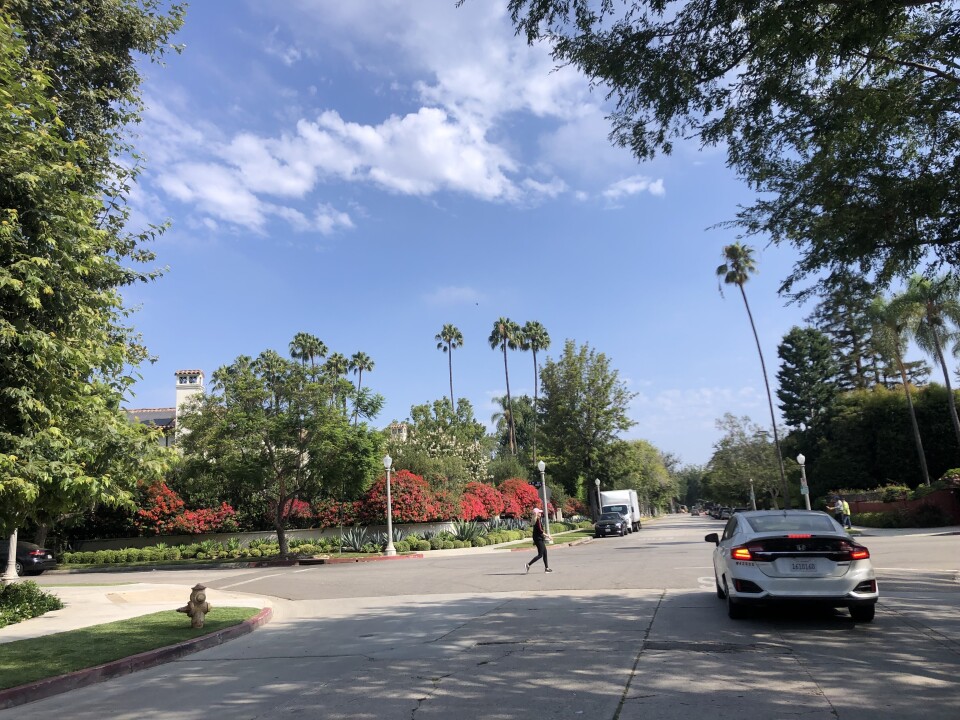Truth matters. Community matters. Your support makes both possible. LAist is one of the few places where news remains independent and free from political and corporate influence. Stand up for truth and for LAist. Make your year-end tax-deductible gift now.
Most Angelenos Are Fighting The Drought. And On The Lawn Level, 'Water Cops' Want To Keep Things On Track

I’m walking a lawn- and tree-lined street in the west side neighborhood of Hancock Park with Damon Ayala, a patroller with the Water Conservation Response Unit of the L.A. Department of Water and Power.
We walk past a patch of grass and sidewalk recently wetted by sprinklers. Ayala saw the sprinklers go off — it’s a Wednesday, a day no one is allowed to water, so he’ll mail a citation to the homeowner. He’s already written a couple other citations this morning.
Current rules restrict Angelenos to two days of outdoor watering: Monday and Friday for odd addresses and Sunday and Thursday for even ones.
Water Agencies Affected By Drought Restrictions
More than 6 million Californians served by the Metropolitan Water District of Southern California (MWD) can only water outside once or twice a week. Here are the affected agencies:
- Calleguas Municipal Water District
- Inland Empire Utilities Agency
- Las Virgenes Municipal Water District
- Los Angeles Department of Water and Power
- Three Valleys Municipal Water District
- Upper San Gabriel Valley Municipal Water District.
While most California cities have some level of water restrictions in place as the climate crisis makes drought the new norm, not everyone is affected by new drought rules. Here's why.
Ayala said it’s this homeowner’s first warning, but if they break the rules again, they’ll get a $200 fine. By the fourth violation, it’s $600 bucks. (You can get the details on the city of L.A.’s restrictions here.)
Ayala is one of only eight LADWP specialists enforcing rules across the city. His unit’s been colloquially dubbed “water cops,” but Ayala prefers a different label.
“We're more like water educators, because our primary objective is not to fine anybody…fines do not help us save water,” he said. “We'd rather educate and get behavioral change.”
Usually when water waste merits a citation, it’s just because the homeowner is unaware, he said. And fines do little to stem the flow of L.A.’s biggest and wealthiest residential users, Ayala said. But overall, he’s seen Angelenos overwhelmingly abiding by the rules.

In June, when restrictions officially started, Angelenos stemmed water use 9% from the same time last year, a record low for that month, and the city is on track to further lower use in July, according to LADWP.
The reduction kept L.A. in line with new monthly water limits, according to the city, and leaves Angelenos using just under an average of about 112 gallons of water per day, slightly down from April use, despite hotter weather (water use tends to go up when it’s hotter). The goal is to get that average down to 105 gallons.
That means there’s still a long way to go. If water use doesn’t look like it’ll drop at least 35% across the area served by the Metropolitan Water District of Southern California, the regional wholesaler that supplies water to 19 million people in the Southland, including 4 million here in L.A., Southern Californians could face an all-out ban on outdoor watering as soon as fall.
But Angelenos are holding each other accountable. LADWP received nearly 2,000 water waste complaints in June, when restrictions started — a 56% increase from May. Out of those cases, LADWP found 49 cases meriting a citation and issued no fines.
Ayala chooses where to patrol largely based on the complaints the department receives from residents. He said the ballooning volume in calls is a sign people are aware of the severity of the drought.
“People are aware and our job is to make them more aware and reach out to those who aren't,” he said.
Water waste complaints come from all over the city, but, according to 311 data, so far they’ve mostly come from some of the highest water-use areas: mid-Wilshire, which includes Hancock Park, and Brentwood, home to the largest share of the city’s biggest water users, according to data shared with LAist by LADWP.
That doesn’t mean people are flouting the rules in those areas — it just means neighbors are perhaps keeping a closer eye on each other’s water use. Last year, before the stricter water rules began, residents in Hollywood, Brentwood and Pacific Palisades received the bulk of citations in the city between July, August and September, according to data provided to LAist by LADWP.
Hancock Park resident Shlomete Yoo said she thinks most of her neighbors are doing their part and sticking to the rules.
“A lot of neighbors have stopped, but then there's some people who seem to…don't know or have ignored the new regulations,” she said with a shrug and a laugh. “So it's a mixed bag here.”
She said she herself uses rain or gray water collected in barrels to water the trees and plants on their property. The restrictions haven’t affected her much because her family quit watering their lawn almost as soon as they moved here two years ago.
“We're New Yorkers, so we're used to free, plentiful water all the time,” she said. “So when we moved here and we saw our first water bill, we were shocked.”
She said that kicked them into high water-saving gear. Now, they’ve learned to live with the dryness of California — for the savings and the climate.
Ongoing drought fueled by the climate crisis has left L.A.’s biggest water supplies critically low. More than 40% of the city’s water comes from dwindling reservoirs in Northern California. By the numbers, nearly all of that water feeds lawns: the city says 35% of its water goes to outdoor landscape irrigation, mostly at homes. That’s why these restrictions are in place.
I also chatted with a gardener mowing a nearby lawn—he declined to give his name, but said his business and the yards he cares for haven’t suffered too much from the new restrictions… yet. He said his biggest concern is worsening heat, both in the forecast this summer and in the long run as greenhouse gas emissions continue to heat up the planet. He’s felt it himself, he said, wiping his brow as the time reached 11 am.
“It’s gonna be hotter and hotter,” he said. “Basically if politics doesn’t do anything about it…it’s gonna be worse.”
Helpful Links To Save Water And Money
Updated July 29, 2022 at 9:48 AM PDT
This story was updated to include a link to report water waste.








